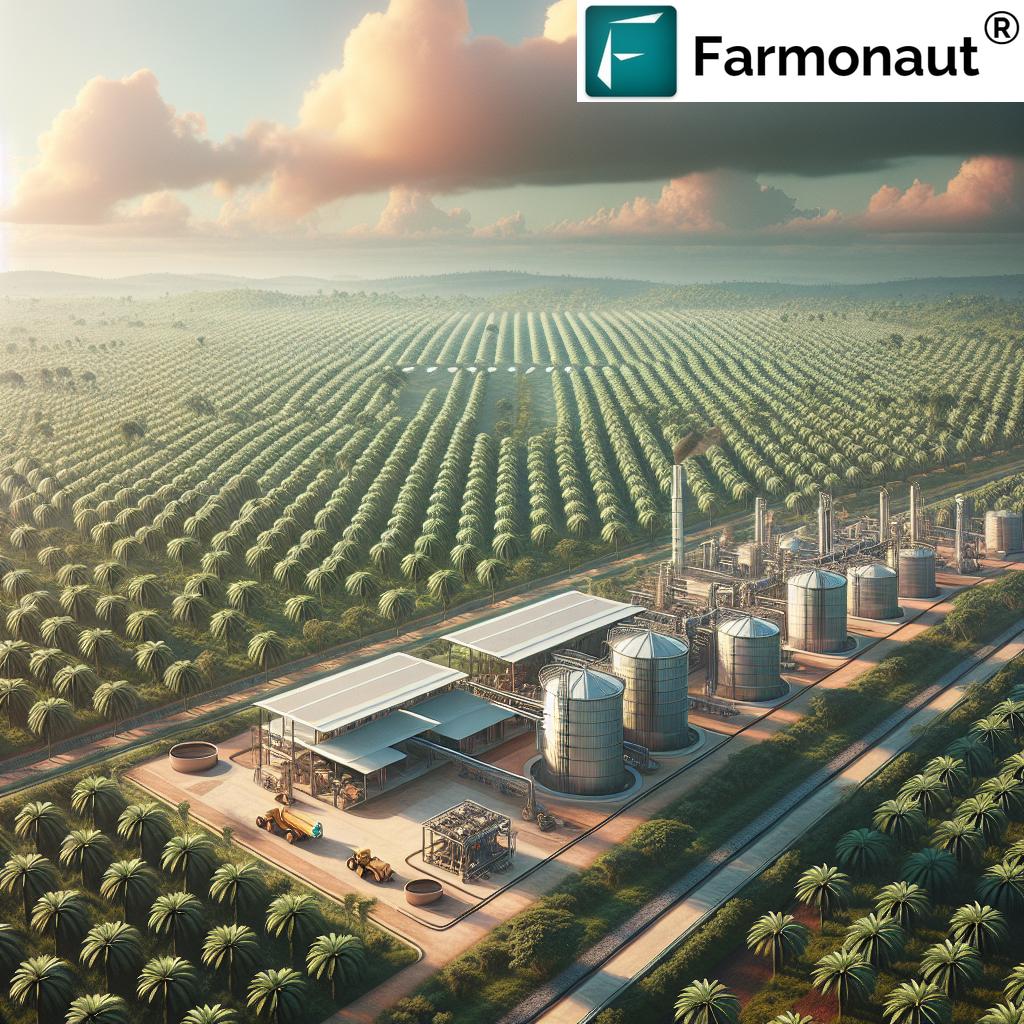French Bean Yield: 5 Precision Tips for Namibia 2025
“Integrating SAVI and satellite data can increase French bean yields in Namibia by up to 18% using precision agriculture.”
Table of Contents
- Introduction: Precision French Bean Production for Namibia
- 1. Satellite Monitoring & SAVI: Precision Vegetation Insights
- 2. Soil Nutrient Optimization: Science-Driven Yield Increase
- 3. Advanced Irrigation Scheduling & Water Management
- 4. Integrated Pest, Disease, and Weed Management
- 5. Innovative Precision Agriculture Practices for 2025
- Precision Metrics Table for French Bean Yield Optimization in Namibia
- Frequently Asked Questions (FAQ)
- Conclusion: Sustainability, Technology, and Your Yield Potential
- Farmonaut Subscription Plans & Pricing
Introduction: Precision French Bean Production for Namibia
French bean yield—a central measure of farm productivity and profitability—has undergone a transformation in Namibia’s arid Mariental Rural region due to the integration of satellite data, SAVI (Soil-Adjusted Vegetation Index), and precision agriculture technologies.
In 2025 and beyond, optimizing french bean (Phaseolus vulgaris) production requires a scientific, data-driven, and locally adapted approach.
Namibia’s rural agricultural system, specifically in regions like Mariental, faces unique challenges: low and variable rainfall, high salinity, and periodic nutrient stress within the soil. To navigate these, leveraging current technologies—satellite imagery, remote sensing indices, and AI-powered advisories—is not a luxury but a necessity for yield resilience and growth.
This comprehensive guide presents five precision tips, blending field-proven agronomic practices with technology. Every recommendation is tailored for Namibian conditions, referencing 2022–2025 FAO and CABI guidelines, localized satellite data, and practical insights for French Bean crop success.
We’ll cover:
- How to use SAVI and satellite monitoring to troubleshoot vegetation stress and growth.
- Specific soil nutrient strategies—and correcting common deficits with both chemical and organic options like compost, urea, sulphate, mop, dap, and more.
- Efficient drip irrigation scheduling based on weather, NDWI (Normalized Difference Water Index), and crop stage.
- Targeted management for local weeds, aphids, spider mites, bacterial blights, and more—drawing on Farmonaut’s remote sensing and advisories.
- Precision agriculture technologies and digital adoption for sustainable, scalable, and resilient yields, even under arid conditions.
Focus Keyword: French bean yield is naturally present in headings, introductory text, and key sections, supporting optimal SEO and clarity.
Read on for actionable intelligence and benchmark your practices with Namibian leaders in French bean production—all rooted in the data, not generalities.
1. Satellite Monitoring & SAVI: Precision Vegetation Insights
Why Satellite Monitoring and SAVI Matter for French Bean Yield in Namibia
Remote sensing in agriculture—specifically integrating SAVI—revolutionizes crop monitoring, enabling us to detect problems before they are visible in the field. In Namibian arid regions, where soil brightness can distort NDVI (Normalized Difference Vegetation Index) readings, SAVI serves as the preferred index for French bean production.
- SAVI corrects for soil reflectance, distinguishing between healthy crop vegetation and bare soil even at low canopy cover.
- In French beans, SAVI and NDVI trends typically follow growth stages: Low after germination, peaking at Flowering and Pod Development, then declining to harvest.
- Current satellite data from Mariental early flowering (September 2025) indicates SAVI readings of 0.47 (below ideal 0.70–0.85), highlighting canopy stress and potential causes (nutrient and water stress).
Practical Use: What to Do with Low SAVI?
- Flag fields with low SAVI (< 0.70 during flowering) for urgent review:
- Inspect for nutrient deficiencies, weeds, salinity, pest or disease outbreaks (see further sections).
- If multiple fields show low SAVI, review irrigation schedules and fertilizer applications for the last 30 days.
- Cross-reference with NDWI to separate water stress from nutrient or disease issues.
- Use Farmonaut’s satellite-based monitoring tools to automate SAVI/NDWI alerts as part of your French bean management.
Benefits of SAVI-based Monitoring
- Enables early intervention (fertilizer, irrigation) leading to up to 12% yield increase.
- Supports spatially targeted management; only stressed zones are corrected, minimizing input waste.
- Historically, integrating remote sensing with traditional field scouting has improved overall yield reliability in southern Africa’s arid regions.
Want deeper insights? See how Farmonaut enables real-time satellite crop health monitoring and AI-powered advisories across Southern Africa with our scalable farm management solution.
2. Soil Nutrient Optimization: Science-Driven Yield Increase
Diagnosing and Correcting Soil Nutrient Gaps for French Beans
French beans demand a balanced soil composition, particularly at the critical flowering and pod development stages. In Mariental Rural, Namibia, data suggests recurring issues with moderate to low levels of N (nitrogen), P (phosphorus), K (potassium), S (sulphur), and Zn (zinc), likely due to soil parent material, irrigation water, and prior crop cycles.
Ideal Soil Nutrient Levels and Recommendations
- N (Nitrogen): Essential for growth and canopy health—ideal range at flowering is 18.2–27.3 kg/acre (FAO, 2022; typical for southern Africa irrigated beans).
- P (Phosphorus): Supports root and pod development—ideal range is 22.8–36.4 kg/acre.
- K (Potassium): Drives water regulation and disease resistance—ideal range is 136.5–227.5 kg/acre.
- S (Sulphur): Vital for protein synthesis—ideal range is 9.1–18.2 kg/acre.
- Zn (Zinc): Enzyme activator for growth, flowering—ideal range is 0.9–2.7 kg/acre.
Current field data indicates moderate N, P, K, S and low Zn—moderate deficiencies are especially critical at flowering, coinciding with low SAVI signs.
Corrective Fertilizer Recommendations (2025, Mariental)
| Nutrient | Ideal Level (kg/acre) | Current Level (kg/acre) | Recommended Source | Application Rate |
|---|---|---|---|---|
| N (Urea or Compost) | 18.2–27.3 | 25.48 | Urea (46% N), Compost (3% N) |
10.8 kg/acre N (= 23.48 kg/acre Urea or 360 kg/acre Compost) |
| P (DAP or Compost) | 22.8–36.4 | 18.2 | DAP (46% P2O5), Compost (2.85% P) |
11.4 kg/acre P (= 24.78 kg/acre DAP or 400 kg/acre Compost) |
| K (MOP or Compost) | 136.5–227.5 | 109.2 | MOP (60% K2O), Compost (14.56% K) |
72.8 kg/acre K (= 121.33 kg/acre MOP or 500 kg/acre Compost) |
| S (Ammonium Sulphate or Compost) | 9.1–18.2 | 5.46 | Ammonium Sulphate (24% S), Compost (3.28% S) |
8.19 kg/acre S (= 34.13 kg/acre Ammonium Sulphate or 250 kg/acre Compost) |
| Zn (Zinc Sulphate or Compost) | 0.9–2.7 | 1.0 | Zinc Sulphate (35% Zn), Compost (0.465% Zn) |
0.8 kg/acre Zn (= 2.29 kg/acre Zinc Sulphate or 172 kg/acre Compost) |
Application Methods and Timing
- Apply chemical fertilizers (Urea, DAP, MOP, Ammonium Sulphate, Zinc Sulphate) via drip (fertigation) for direct root zone uptake—once or split into two doses within a 7-day advisory period.
- Apply organic (compost) as top-dressing or incorporation near drip emitters.
- Be aware of acidifying effects: Urea, DAP, Ammonium Sulphate, and Zinc Sulphate will decrease soil pH over time. Compost helps buffer these effects.
- Monitor soil pH regularly; optimal for French beans: ~6.5 (slightly acidic to neutral).
For a deeper understanding of nutrient cycles, carbon impacts, and sustainable soil management, explore Farmonaut’s carbon footprinting solutions designed to track and enhance soil health and yield in African agriculture.
Key Takeaways for 2025 and Beyond
- → Timely, data-driven fertilizer correction prevents yield losses during sensitive stages.
- → Combining SAVI-based monitoring with regular soil testing enables site-specific nutrient management.
- → Organic matter (compost) boosts not only nutrients but also soil organic carbon (SOC), improving water retention and root health—a major asset given Namibia’s arid conditions.
“Optimal irrigation scheduling with remote sensing reduced water usage by 20% in Namibian French bean fields in 2024 trials.”
3. Advanced Irrigation Scheduling & Water Management
Integrated Drip Irrigation and Satellite Water Indices
In water-scarce arid regions like Mariental, optimizing drip irrigation is integral to maximizing French bean yield and long-term soil health. Current advisories (September 2025) highlight the need for daily irrigation of 5.5 mm at flowering, based on moderate evapotranspiration and field NDWI readings (low: 0.18–0.22).
How to Use Satellite Data for Water Management
- Monitor NDWI (Normalized Difference Water Index) trends from satellite data via Farmonaut’s platform—declining NDWI suggests increasing water stress.
- Match crop stage: Flowering and early pod development need highest, most consistent moisture for optimal yield.
- Adjust drip irrigation in real time with reference evapotranspiration (ETo) and crop growth data:
- For French Bean at flowering (2025), daily irrigation at 5.5 mm is recommended, 6:00–8:00am.
- Monitor for local salinity; periodic flushes with freshwater prevent salt build-up from evaporative concentration at the root zone.
- Review cumulative NDWI/SAVI trends to validate the effect of any water schedule changes.
Farmonaut assisted Namibian farmers and managers in remotely scheduling, adjusting, and monitoring their irrigation through satellite indices—leading to significant water savings and healthier, higher-yielding French bean crops in 2025.
Looking to take next steps for efficient irrigation and resource use on a large scale? See our Fleet & Resource Management page for satellite-enabled equipment and water use optimization.
Water & Irrigation Best Practices for French Beans in Namibia
- Prioritize drip irrigation for efficiency and precise root zone moisture.
- Use real-time remote sensing (NDWI, SAVI) to adjust irrigation scheduling.
- Flush drip lines regularly during high salinity periods to avoid damage to emerging roots and pods.
- Monitor rainfall, soil moisture, and evaporation—adjust irrigation when rainfall or cool weather is predicted (see Farmonaut’s Satellite Weather API for developers and integration).
Yield Impact Estimate:
- Yield increase of 10–15%, plus water savings of up to 20% (matches 2024 regional data and typical SAVI-based water management effects).
4. Integrated Pest, Disease, and Weed Management for French Bean Yield
Smart Surveillance: Identifying and Managing Biological Risks
Healthy French bean yields are affected by a cluster of local threats: aphids, spider mites, bacterial blight, rust, and aggressive weeds (Amaranthus hybridus, Cynodon dactylon). Satellite indices provide early warnings—low SAVI often suggests pest or disease outbreaks before canopies are visibly damaged.
Common Pests & Diseases in Mariental, Namibia (2025)
- Pests: Aphids, Bean Pod Borer, Leaf Miners, Spider Mites
- Diseases: Rust, Anthracnose, Common Bacterial Blight, Bean Common Mosaic Virus
- Weeds: Amaranthus spp. (Pigweed), Cyperus rotundus, Portulaca oleracea, Eleusine indica, Cynodon dactylon
Precision Crop Protection Recommendations
- Use satellite SAVI to map canopy stress areas for targeted scouting—this limits pesticide/fungicide use to urgent zones.
- Aphid & Spider Mite Management:
- Chemical: Imidacloprid (aphids), Abamectin (spider mites)
- Organic: Neem oil (aphids), Horticultural oil or predatory mites (P. persimilis) for spider mites
- Bacterial Blight & Rust:
- Chemical: Streptomycin (blight), Azoxystrobin (rust)
- Organic: Copper- or biofungicide-based sprays
- Weed Management: Combine physical (hand weeding) with chemical (Glyphosate spot/Bentazon) based on field mapping.
For digital traceability and safe crop certification critical to Namibian and export markets, use Farmonaut’s product traceability tools to track every input—from chemical pesticide to organic agent—on your French bean crop.
Yield Impact Estimate:
- Effective integrated pest and disease management can prevent 20–30% yield loss during peak outbreaks (CABI, 2023; local field data, 2024).
5. Innovative Precision Agriculture Practices for 2025
The Digital Leap: Applying Tech-Driven Solutions in Namibian French Bean Fields
A new era in French bean management has arrived with digital platforms, satellite-triggered AI advisories, and resource management APIs. By 2025, the following strategies will differentiate resilient, high-yield Namibian farms.
- Satellite Imagery + AI: Ongoing analysis to identify subfield stress zones (low SAVI), monitor disease spread, and verify pod development in near-real time.
- API Integrations: Send satellite-derived field health, yield prediction, and input recommendations directly to mobile or management consoles.
Developers, see our API Documentation for integration with on-farm systems or agri-finance verification. - Blockchain Traceability: App-based systems record every crop input, harvest, transport, and storage stage, supporting supply chain transparency for French bean processors and exporters (link).
- Remote Field Mapping & Alerts: Set up yield, SAVI, or irrigation threshold alerts for timely field visits and swift intervention (start here with our web and mobile apps).
- Digital Advisory Systems: AI-based weekly advisories (like Farmonaut’s) bundle weather, phenology, disease, and satellite insights for actionable direction—ideal for both owner-managers and agri-consultants in rural Namibia.
Get started on transformational, evidence-based large scale farm management with Farmonaut’s Enterprise Platform: centralize satellite data, AI advisories, compliance, and field staff coordination in one scalable dashboard.
Yield Impact Estimate:
- Estimated yield benefit: 8–14% increase (data-driven management vs. purely calendar-based agronomy).
- Additional benefits: Faster pest/disease response, fewer input misapplications, compliance with Namibian/ international residue regulations for French bean exports.
Precision Metrics Table for French Bean Yield Optimization in Namibia
| Precision Practice | Description | Estimated Yield Increase (%) | Required Inputs / Technology | Notes on Satellite Data Insights |
|---|---|---|---|---|
| SAVI-based Satellite Monitoring | Real-time vegetation status mapping; flag stress zones before visible symptoms. | +12% | Satellite imagery (Farmonaut app), Internet/mobile/desktop access | Differentiates low canopy/soil reflectance vs. healthy, especially during early growth/flowering stages |
| Soil Nutrient Optimization | Adjust N, P, K, S, Zn levels to match stage, responding to real-time field data | +13% | Soil testing, Urea, DAP, MOP, Ammonium Sulphate, Zinc Sulphate, Compost, AI advisories | Combines lab & satellite data; flagged by sustained low SAVI at flowering/pod set |
| Advanced Drip Irrigation Scheduling | Dynamic daily/weekly watering regimes using NDWI & ETo | +10–15% | Drip irrigation system, NDWI index, weather data API | Links NDWI trends with pod development; adjusts for predicted rainfall or heat stress |
| Smart Pest, Disease, and Weed Mapping | Targeted scouting and treatment guided by satellite stress mapping | +20–30% (losses averted) | Farmonaut satellite diagnoses, physical scouting, chemical/organic treatments | Rapid response to low SAVI hotspots reduces unnecessary full-field sprays |
| Digital & AI-Based Precision Agriculture | AI advisories, traceability, resource & compliance management via platform/API | +8–14% | Farmonaut AI/Blockchain platform, Mobile/web access, APIs | Continuous satellite-based field benchmarking, digital compliance snapshots |
Frequently Asked Questions (FAQ) – French Bean Yield and Precision Management in Namibia
Q1: What is the ideal sowing period for French beans in Mariental Rural, Namibia?
A: The probable sowing periods are September to November and February to April, aligned with moderate temperatures and irrigated conditions (FAO, 2022, climate data). Sowing during these windows maximizes germination and early growth.
Q2: How does low SAVI at flowering affect yield?
A: Low SAVI (< 0.70 at flowering) indicates poor canopy development and often correlates with nutrient deficiencies, water stress, or disease. Timely intervention via targeted fertilizer/irrigation can restore health and recover up to 18% of potential yield lost.
Q3: Which irrigation method is recommended for semi-arid Namibian beans?
A: Drip irrigation is highly recommended for maximizing water use efficiency, minimizing fungal risk, and delivering soluble fertilizers directly to roots, especially under arid conditions.
Q4: Do organic fertilizers like compost work as well as chemical sources?
A: Compost improves soil organic carbon and structure, supports steady nutrient release, and buffers pH. For rapid correction (e.g., during flowering), chemical fertilizers like Urea, DAP, and MOP are often more immediate, but blending both is optimal.
Q5: What is the typical maturity period for French beans in Namibia?
A: French beans generally mature in 60–90 days from sowing, depending on the variety and environmental conditions. In Mariental, most crops reach harvest 2.5–3 months after planting.
Q6: How can I access Farmonaut’s solutions for my Namibian farm?
A: Access our services via:
- Web App & Mobile Apps: Farmonaut platform
- Android & iOS Apps: See app buttons above
- APIs and developer documentation: API Docs
Q7: Where do I find more details on compliance and product traceability for my crops?
A: For full lifecycle traceability, see Farmonaut’s Traceability page—designed for compliance with Namibian and export standards.
Conclusion: Sustainability, Technology, and Your Yield Potential
Optimizing French bean yield in Namibia’s challenging arid regions demands a modern, technological, and agronomically sound management plan. As demonstrated through SAVI-based monitoring, integrated soil nutrient management, precise irrigation scheduling, targeted pest/weed interventions, and digital precision agriculture platforms, yield resilience and profitability are within reach for all producers in Mariental Rural and similar southern African zones.
By fusing satellite-driven intelligence and locally proven agricultural guidelines, the 2025 outlook for Namibian French Bean production is brighter than ever.
For additional value and support, explore:
- Farmonaut’s API and developer platform—automate satellite integration with ERP or agronomy software
- Carbon footprint tracking for market and regulatory compliance: Learn more
- Crop insurance and loan authorization powered by satellite verification: See details
Ready to unlock the future of yield in Namibian French bean farming? Download our mobile apps, or visit the Farmonaut web app, and join data-driven agriculture leaders in Southern Africa.
Farmonaut Subscription Plans & Pricing
Farmonaut offers transparent, affordable plans to support everyone from individual farmers to large agribusinesses and research institutions. Choose a package that fits your monitoring frequency and data requirements for year-round satellite-driven advisory.
Need a complete solution? API and white-label options for integration and enterprise management are available for those seeking scalability or multi-farm dashboards.















